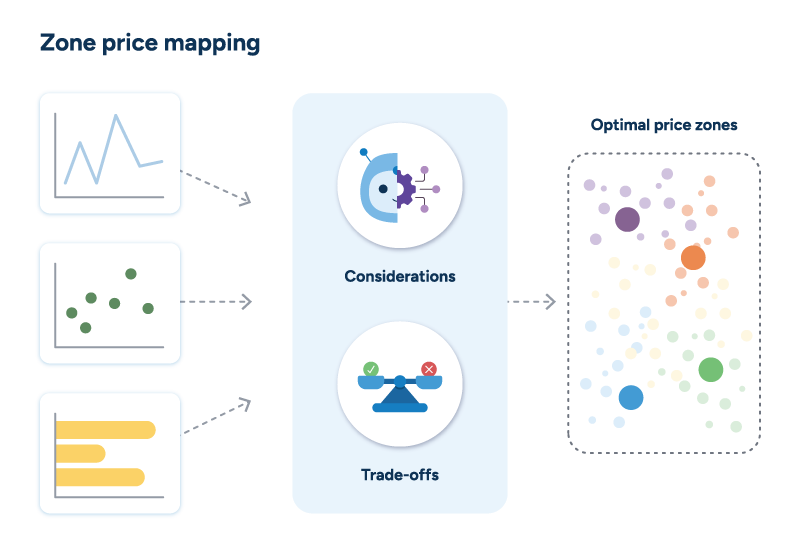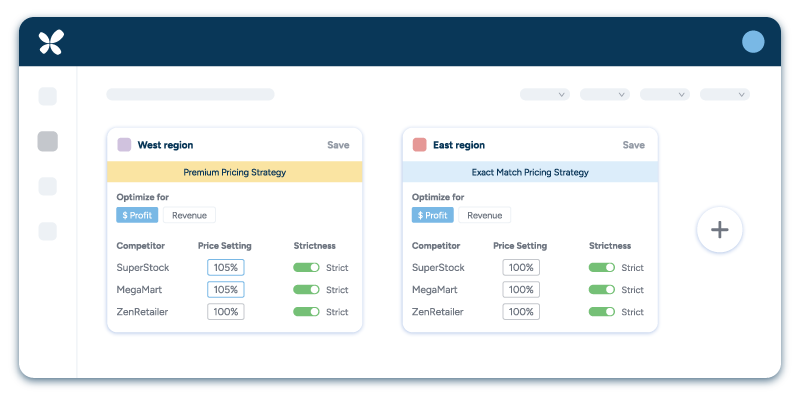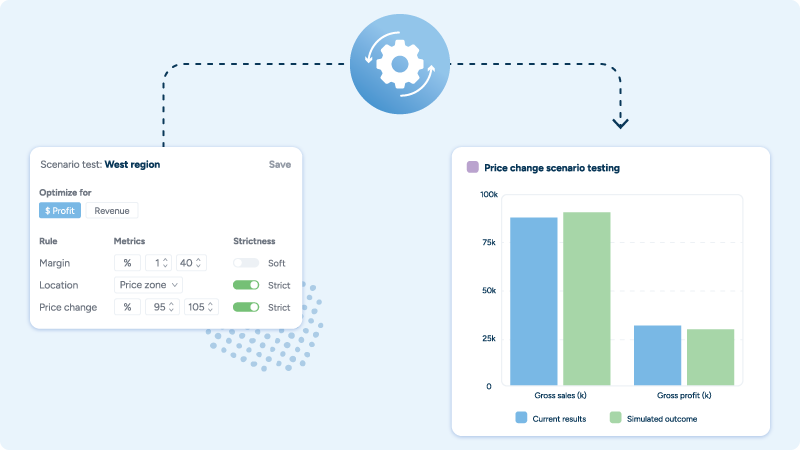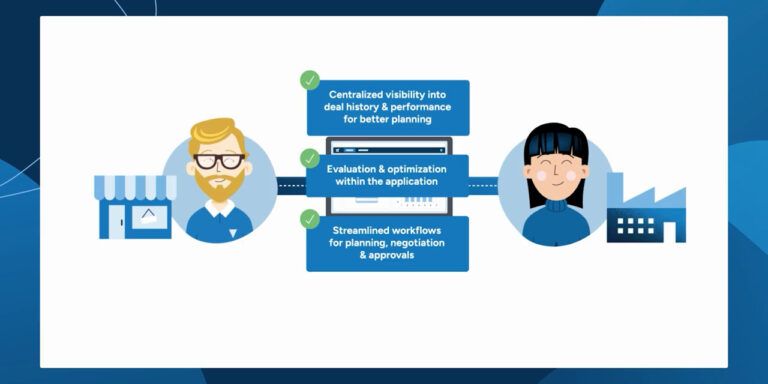Zone pricing: Driving growth with region-specific pricing
May 2, 2025 • 9 min
Price perception, competition, operational costs, and consumer budgets typically vary across a country. This variation challenges retailers in setting appropriate prices for diverse geographical locations. Pricing too low in the wrong places prevents opportunities to recoup costs or generate more profit. Similarly, increasing prices in areas with high levels of competition or price sensitivity may result in lost sales or market share. None of these situations is good for business.
Successful pricing requires nuance and careful consideration of regional markets. Zone pricing solves this dilemma, allowing retailers to reflect the conditions of local areas in their prices, keeping customers satisfied and the business profitable. However, to effectively establish and manage zones, you need the appropriate tools. A solution like RELEX provides capabilities that let you create optimal zones and automatically adjust pricing, driving store traffic and profit gains where possible.
What is zone pricing?
Zone pricing (store clustering) groups retail locations into distinct categories based on shared market characteristics. This strategy enables retailers to adjust product pricing across different places according to local consumer purchasing power, competitive pressures, and operational capabilities — optimizing revenue by aligning prices with what each market will bear.
Tailoring prices to regional market dynamics can substantially improve store performance. Effective zone pricing allows for nimble adjustments to your pricing strategy as consumer behaviors evolve, ultimately driving higher satisfaction and loyalty through enticing price points.
What goes into determining zones?
Retailers can combine data on price elasticity, customer demographics, local competition, and store history and format to define coherent price zones with consistent and strategic pricing. Once the price zones have been established, it’s important to ensure that the number you’ve produced is manageable for your operation, that they’re distinct enough from one another, and that stores in the same price zones are sufficiently similar.
Determining price zones effectively is no easy feat. It requires refined, tried, and tested techniques to analyze an incredible amount of data and identify natural clustering patterns. As a result, some retailers hire consultants to create their price zones. However, this approach is costly and impractical, as consultants charge a high hourly rate, and the business ends up depending on them to make critical changes.
To effectively determine price zones, retailers need advanced solutions that are capable of processing vast amounts of data. These solutions are designed for teams launching or expanding their zone pricing strategies. They facilitate rapid adoption and deployment while offering scalability to accommodate evolving business needs.
National pricing vs zone pricing
National pricing — uniform pricing across all locations — may be initially appealing due to its operational simplicity. However, this approach ignores the diverse economic and competitive landscapes in which modern retailers operate, making it both impractical and economically inefficient.
Many retailers turn to zone pricing to address the variances in conditions between neighborhoods, towns, and cities. By adjusting prices to match the conditions of each market, retailers can effectively optimize margins in affluent areas while staying competitive in price-sensitive regions. These types of pricing decisions would not be possible with the one-size-fits-all approach.
For example, a RELEX customer in Estonia had implemented uniform national pricing, overlooking significant regional economic disparities. Their pricing appeared excessive in less affluent eastern regions while underpricing in the wealthy northwest, negatively impacting profitability and price perception. With RELEX, they utilized zones to align prices with local purchasing power, improving customers’ perceptions of cost and the business’s profitability.
Some large ‘budget’ chains offer consistent national pricing and standardized assortments as part of their brand promise. However, for most retailers, this is often unfeasible and does not compare to the potential gains from implementing zone pricing, which can be up to a percentage point in gross profit margin when done effectively.
The benefits of zone pricing
Implementing zone pricing provides retailers with a range of benefits, helping them respond more effectively to varying market factors, maximize profits, and take operational costs into account in their pricing.
Increased profitability
Given retailers’ typically slim net margins, optimizing pricing to bolster profit is crucial to business success. Since zones factor in price elasticity, you can pinpoint where you can raise prices without losing sales, boosting your bottom line.
Essentially, zone pricing helps maximize profits by strategically lowering prices only on those key items that customers in specific regions really care about while maintaining better margins on products that fly under the radar of price perception. This approach means you can protect your profitability, as you only need to set aggressive prices in zones where customers are truly price-sensitive, keeping your profits healthy across your entire store network.
Enhanced competitiveness
Zone pricing allows you to fine-tune prices exactly when and where they matter most to strengthen your competitive advantage. Consider a competitor who has recently increased prices in a specific area. The ability to quickly adjust prices in the exact location helps you attract cost-conscious shoppers and grow market share. Likewise, zone pricing lets you react to local competitors’ discounts to maintain your competitive edge and protect your price perception in the community.
By using zone pricing to consistently offer the most compelling deals in specific neighborhoods, you make it harder for competitors to lure away your local customers. This loyalty becomes valuable in competitive markets where customers have abundant choices and keep a close eye on prices.
Better cost management
Retailers must contend with varying local operational expenses, including supplier costs, transportation, wages, and taxes. With zone pricing, you can calibrate prices to underlying regional cost differences. For example, setting a minimum margin requirement per zone ensures prices are sufficient to cover the varying operational costs and, at the same time, generates profit.
When products cost more to transport to certain locations, you can set pricing parameters that keep stores in those locations profitable despite higher expenses. This allows every store in your network to contribute positively to your bottom line, regardless of logistical challenges. Success depends on implementing a flexible zone pricing strategy that accurately accounts for business costs across regions.
Improved customer satisfaction
Instead of implementing a standardized pricing strategy that risks customer dissatisfaction, zone pricing allows you to calibrate price points according to market conditions and product preferences. This includes strategic discounts on high-visibility products that matter most to local customers. Essentially, you can boost customer satisfaction by aligning your pricing with distinct localized shopping behaviors.
During inflation, price-sensitive neighborhoods feel the pressure most acutely. By implementing zone prices, you can maintain affordability in these areas, demonstrating that you recognize the challenging circumstances for these particular customers rather than ignoring economic realities. This approach builds lasting loyalty beyond initial gratitude—customers remember brands that stood by them during difficult times.
What prevents effective zone pricing?
Several major factors hinder the success of zone pricing, complicating effective implementation and scaling.
Poor data foundations
Effective price zones must be built on strong data foundations, which some retailers struggle to establish. Historical transaction data for determining price zones often contains gaps, inconsistencies, and outdated information. These deficiencies hinder analysis, making it difficult for retailers to identify meaningful zones or understand regional price elasticity. While perfect data isn’t a necessity, it should be sufficiently clean to enable extraction of useful insights for forecasting the effects of price changes across zones.
Scaling zones too quickly
The more price zones you establish, the more you can tailor pricing to specific locales. However, this increased granularity can produce significant operational challenges. Too many zones typically produce diminishing returns while making it increasingly difficult to effectively monitor, maintain, and implement price adjustments across your network.
In addition, implementing too many pricing zones can create supply chain complications. Multiple price variations often lead to unpredictable demand patterns, causing stockouts in some locations while others accumulate excess inventory. Start with a few well-defined zones, carefully evaluate their performance, and then scale gradually. This measured approach lets you capture regional pricing opportunities while keeping implementation manageable as your operation adapts to this new system.
Lack of technological maturity
Slow processing, siloed systems, and inflexible, basic price rules. Retailers who depend on legacy technology severely limit their ability to identify or manage zones. As a result, they are often left implementing localized pricing strategies that lack versatility or sophistication. This ultimately compromises their competitive position in varied market environments and prevents them from achieving their business goals for growth.
For instance, before implementing RELEX, one prominent American supermarket had identified eight distinct price zones but could only effectively manage two. Their legacy system was too complex and cumbersome, forcing them to simplify their zoning strategy. They are currently working with RELEX to incorporate pricing zones that will allow them to tailor pricing approaches for all their identified regions with minimal complexity.
Modern retailers who succeed with price zones use advanced, intelligent pricing tools. RELEX can support the entire zone pricing process — from zone creation to price optimization — while forecasting how these decisions impact demand, sales volume, and profit margins.
Unlocking the power of zone pricing with technology
Cutting-edge technologies have transformed zone pricing by simplifying complex operational processes, empowering retailers to seize profit or market share growth opportunities while drastically reducing the effort required for localized pricing. Here are the solutions that are changing the game.
Intelligent zone mapping

An advanced machine learning model underpinned by deep neural networks can help you determine the optimal number of price zones. The model independently clusters your stores into logical zones by analyzing our receipt data to extract price elasticity patterns, store attributes, competition, demographics, and purchasing behaviors. It also accounts for regional cost structures and your business’s operational capacity in the calculation.
For instance, the RELEX pricing solutions detects patterns that conventional approaches overlook and performs zone analysis significantly faster than manual methods. Its systematic, methodical approach to determining zones replaces guesswork with data-driven precision. As the model manages all the complex multi-dimensional analysis required for zone determination, your team can create zones without needing technical knowledge.
If your current datasets require refinement, RELEX also provides AI-powered cleansing that automatically corrects errors, eliminates duplicates, and fills gaps using advanced statistical methods, enhancing your zone analysis.
Intuitive rule-based pricing engine

An advanced business rules engine can simultaneously apply price changes for multiple products, categories, or stores from a single custom command. With RELEX, for instance, you can create rules to implement tailored pricing strategies for each zone, considering regional conditions and incorporating business objectives like competitive positioning and margin requirements to calculate optimal prices. These zone-based rules enable region-specific pricing decisions while streamlining the price-setting process.
Conflicts can occur when there are numerous active rules within each zone. Let’s say you want to match a competitor’s lower prices in one zone, but this clashes with the rule you’ve set for minimum margin requirements. The RELEX rules engine resolves this by letting you prioritize rules based on your business objectives: “inviolable” (strict) rules will automatically override “flexible” (soft) ones when conflicts arise. This reduces time-consuming interventions, which can be a blocker to using zone pricing at scale.
Rapid scenario testing

Scenario testing lets retailers see how zone-specific price changes will affect revenue, margin, and profitability before implementing them. Unlike slower systems that can take up to a day to deliver or rerun the simulation, RELEX can provide results nearly instantly, allowing your team to test multiple pricing scenarios across different zones in rapid succession.
With this speed, you can quickly test specific scenarios — like adjusting KVI prices in affluent zones or altering matching rules in high-competition areas — and immediately see the projected outcomes on profit or revenue. Scenario testing is both a tool for pricing experimentation and a safety net against costly mistakes that could harm your market share or pointlessly shrink your profit margins.
The path to success is through zone pricing
In fragmented markets with regional economic disparities, the one-size-fits-all pricing model is simply a non-starter for most retailers. Conversely, tech-enabled zone pricing respects market differences — from competitive intensity to consumer spending power — while remaining operationally realistic. Thus, it helps retailers capture maximum potential profit in affluent areas and maintain affordability where price sensitivity runs high.
With powerful solutions like RELEX, zone pricing has never been more effective and effortless. The RELEX price rules engine handles all the complexity and manual work, allowing you to focus on pulling the strategic levers to drive sustainable growth and competitive differentiation in an increasingly challenging retail environment.



